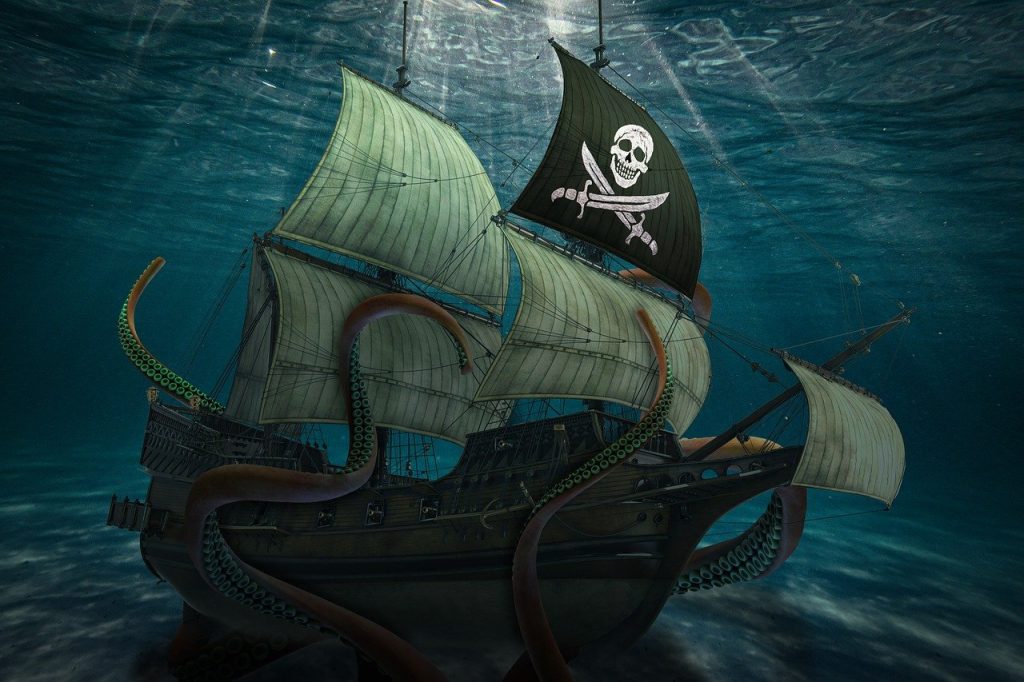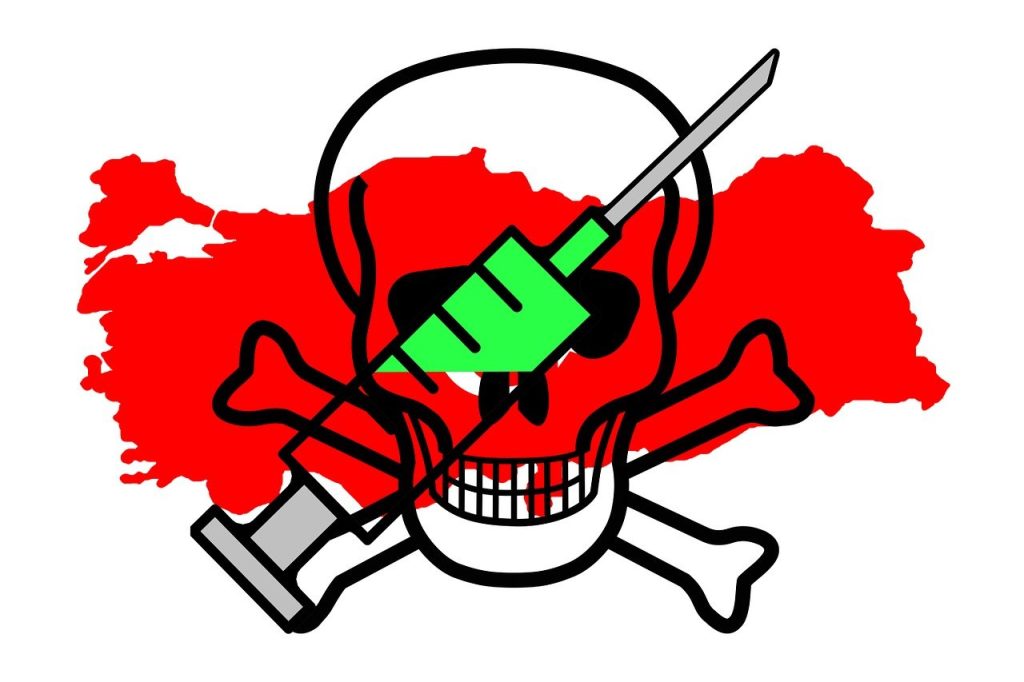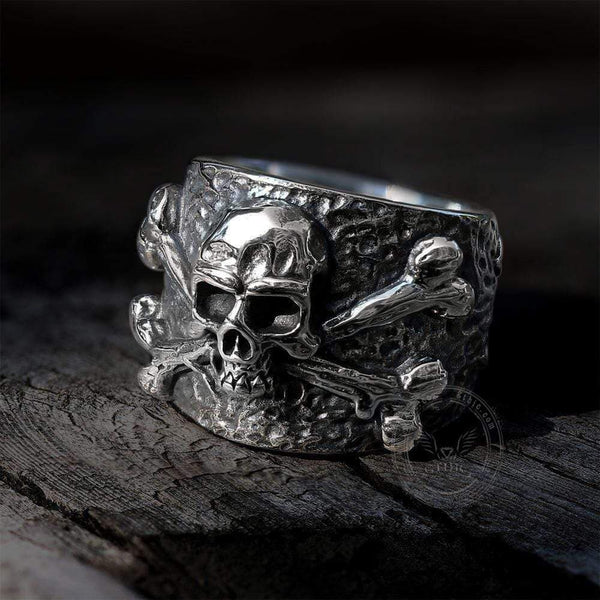The skulls and crossbones, a symbol that has transcended time and cultures, possess a captivating mystique that invokes a myriad of emotions and interpretations. Here we begin a look at the history, meanings, and symbolism behind the iconic image of the skulls and crossbones.
The History of Skull and Crossbones Symbol
The skull and crossbones symbol, with its roots tracing back through centuries, has etched a fascinating narrative in the annals of history. Originating as a memento mori in medieval Europe, it served as a stark reminder of life’s transience and the inevitability of death. This initial incarnation found resonance in a society where contemplating mortality held profound cultural and philosophical significance.

The symbol’s historical trajectory took a notable turn as it embedded itself in the lore of pirates during the notorious Golden Age of Piracy. Known as the Jolly Roger, the skull and crossbones became an emblem synonymous with fear and trepidation on the high seas. Pirates, famed for their unruly lifestyle, elevated this symbol beyond a mere representation of mortality. Raised high on their flags, the Jolly Roger wasn’t just a morbid insignia; it evolved into a tool of psychological warfare.
The combination of a grinning skull and crossed bones on the pirate flag communicated a chilling message: imminent peril awaited those who resisted. Sailors encountering this foreboding symbol understood that defiance could lead to dire consequences. Thus, the history of the skull and crossbones symbol is not just a chronicle of mortality but a dynamic evolution into a powerful emblem, transcending its origins to become an iconic representation of fear and intimidation, leaving an indelible mark on maritime history and popular culture alike.

Meanings and Symbolism of Skulls and Crossbones Symbols
The skulls and crossbones, a potent symbol with a storied past, carries a multitude of meanings that have evolved over time, transcending cultural and historical boundaries. Beyond danger and piracy, the skull and crossbones flag has diverse interpretations.
A Symbol of Danger and Death
At its core, the skull with crossbones conveys a message of danger and impending death. Its association with pirates in the 17th and 18th centuries marked ships as prey for the lawless marauders of the sea. The stark contrast of the white skull against a black background served as a chilling warning, a visual proclamation that resistance would lead to dire consequences. So pay attention to anything with skulls and crossbones! No matter what they are.

A Depiction of “Death or Glory”
Beyond its association with piracy, the skulls and crossbones also embodies the spirit of “Death or Glory.” This symbolism emerged during wartime, notably in military units known for their bravery and commitment to a cause, regardless of the risks. The image became a rallying cry, representing the unwavering resolve to face death in pursuit of a greater purpose.
A Reflection on Mortality
In more reflective contexts, the cross bones skull serves as a meditation on mortality. As a form of memento mori, it prompts individuals to contemplate the transient nature of life and the inevitability of death. In this way, the symbol becomes a powerful reminder to live purposefully and appreciate the preciousness of time.

Rebellion and Independence
The skull and cross bones has also been adopted as a symbol of rebellion and independence. Members of countercultural movements use it to reject societal norms and express a commitment to individual freedom. The image, stripped of its original association with piracy, takes on a new identity—a rebellious spirit challenging conformity.
Modern Applications of the Skulls and Crossbones
In contemporary society, the skulls and crossbones has not lost its impact. Far from being confined to historical contexts, the symbol continues to permeate popular culture and everyday life. From fashion and accessories to branding in various industries, the skulls and crossbones persists as a versatile and potent emblem.
CROSSBONES PIRATE STAINLESS STEEL SKULL RING
Contemporary interpretations often blend traditional symbolism with modern aesthetics. Skull and crossbones tattoos are very popular among young people because they represent rebellion and edginess. The iconic symbol is often associated with danger and adventure. It appeals to the youthful spirit that seeks individuality and self-expression. People use the symbol in furniture decorations, biker jackets, and t-shirts. It’s also found on pants, bandana hats, and other gothic accessories. Additionally, it’s seen in contexts like hazardous substances and pirate flags.

In jewelry design, using intricate skull and crossbones designs made of precious metals like gold or silver can add some edginess to skull rings and jewelry. On the other hand, different designs can exhibit the beauty of gemstones, the boldness of studs, or the daring allure of spikes, offering a wide variety of styles to fit individual tastes.
JOLLY ROGER SIGNET STAINLESS STEEL RING
Moreover, the symbolism of the skulls and crossbones has undergone a cultural transformation. Beyond history, these symbols represent rebellion and freedom, especially in music. Heavy metal, punk, and rap use skulls and crossbones as iconic symbols. They signify subversive spirit and unconventional creativity in these genres. Beyond jewelry, these symbols are cultural markers for defiance and artistic innovation.
Conclusion
In brief, with their rich history and multifaceted symbolism, the skulls and crossbones remain a powerful and enduring icon. Whether embraced for its historical connotations or redefined in modern contexts, this emblem continues to intrigue, provoke thought, and assert its presence as a symbol that transcends the boundaries of time and culture.
Alicia
Alicia is a passionate writer with degrees in English and American Literature. Her journey through the worlds of fashion, culture and design is as fascinating as her literary pursuits. Beyond literature, Alicia is equally an optimist who loves life. Whether it's photography, knitting, pottery, or yoga, she's willing to try it all. Beyond trends and labels, she advocate for sustainability and ethical fashion practices. She believe in the power of conscious consumerism, and she strives to highlight brands that prioritize environmental responsibility and social impact.
Recent Posts
How to Prepare for Halloween Night
10/28/2025Your Bubble Goth Outfits & Style Tips
10/14/2025How to Prepare for the Coming Halloween
09/24/2025Categories
Related Articles
A Guide to How to Train Your Dragon Species
Welcome, fellow dragon enthusiasts and aspiring Viking trainers! Have you ever wondered...
ByAlicia06/24/2025Grunge Aesthetic: A Style Revolution
The world of fashion is a cyclical beast, constantly re-inventing and re-interpreting...
ByAlicia06/03/2025What Is Health Goth
In 2024, “Health Goth” which is hot in 2010s gets back from...
ByAlicia05/27/2025A Beginner’s Guide to Trad Goth: Music, Fashion, and Etiquette
By Bonnie Blackthorn – Vintage Fishnet Addict & Batcave Survivor Hey there,...
ByAlicia03/04/2025














Leave a comment